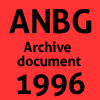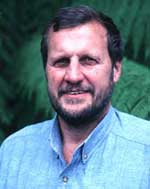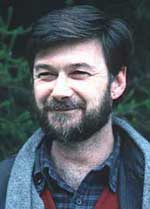 Published in the journal:
Published in the journal:
Australian Net Guide (A.N.G) 4-1996
by John Hilvert (1996)
History of ANBG's Information Technology
Happenstance & Opportunism
The inside story of Canberra's Botanic Gardens' move online
by John Hilvert, 1996
In 1992, before the World Wide Web brought multimedia to the Internet, the Australian National Botanic Gardens in Canberra had one of the most innovative and exciting Internet sites in the world. Some of the first sounds transmitted over the Net were bird songs recorded at the Botanic Gardens. Today, the Gardens has a site on the Web and uses Internet technology for its own internal computer systems.
The Australian National Botanic Gardens (ANBG) presides over the extraordinary variety that is Australia's central plant life collection. The ANBG's Integrated Botanical Information System (IBIS) collects and keeps track of detailed information on 20,840 living plants along with details about over a quarter of a million herbarium plants (its scientific collection of dried plants). In addition they have a photographic collection that includes 19,403 slides. All this information is vital to the work of botanists from Australia and overseas.
The Gardens makes this information available worldwide on the Internet. In fact the Gardens has been a pioneer in using Internet technology both to publish information for external and international use and also to make information available throughout the organisation.
For these purposes, the Gardens in Canberra built one of the first intranets in Australia with e-mail, Gopher, and (more recently) Web access to ANBG's rare and precious holdings, some of which were collected over two centuries ago
An intranet uses Internet protocols and Internet software to drive systems that look like mini mternets contained within a single organisation. Intranets have become fashionable as a cheap but effective way for organisations to share resources and improve their workflow.
Many organisations develop an intranet as the first step towards corporate structuring and to later establishing a significant presence on the Internet.
The Gardens' intranet was created more to ease the workload of inquiries and sup- port requests facing its two full-time systems staff, than as a top-down corporate strategy. Even today, the asset created by IT manager, Jim Croft, and systems manager, Greg Whitbread, is viewed more as 'happenstance and opportunism' by Dr Peter Bridgewater, the CEO of the Australian Nature Conservation Agency (ANCA), which is responsible for the Gardens.
While more than 350,000 visitors a year wander through the Gardens' delightful trails set against the backdrop of Canberra's Black Mountain, the Gardens' pioneering Gopher service and now its Web site already attract 13,000 hits a day; or about half a million virtual visits a year. Initially; there was unease about promoting the Gardens' presence on the Net. Croft recal1s the lengths he had to go to to get ANBG's current domain name, 'anbg.gov.au'. "It was a political issue where another agency wanted ANBG to be a sub-directory of its domain name", Croft told the Australian Net Guide. "There was demurral about any naming or even airing the site unless it took the form of the IP address". In the meantime, over 4000 Web sites referenced the ANBG site by its IP address 'http:/ /155.187.10.52'. Even today, only 14 sites use 'http:/ /www.anbg.gov.au' when making a hyperlink. But getting a domain name was the least of Croft and Whitbread's hassles.
Building a network
 Jim Croft... the chief architect of the Gardens' involvement with the Internet. |
Jim Croft, a botanist by profession, is the chief architect of the Gardens' involvement with the Internet. Back in 1988, when Croft had transferred to the ANBG from a post in Papua New Guinea, he was appalled by the primitive state of its computing systems. In those days, "the ANBG were maintaining handwritten cards for indexing vital specimen information."
This meant storing multiple cards on each plant specimen so that researchers could retrieve data using other fields of information apart from the field used as the main index. Croft was in no mood to persevere with such antiquated methods at the Gardens.
The first change he implemented was establishing a herbarium database so that data would be entered once and then accessed in various ways. Apart from a net- work run from a section of what was then the Department of Capital Territory; the Gardens had no computing resources. "It was very awkward... We needed control over our future as far as computing went."
Croft's first purchase was an NEC 286 PC, leading-edge technology for 1989, with an Oracle database running Xenix (an early version of Unix). In pre-recession times, Croft said, "We were very successful in getting funds to improve the IT in the Gardens."
In response to an audit of the Gardens' herbarium collection, an independent auditor was disturbed to discover there had never been any systematic inventory of the collection. When pressed about the collection's value, Croft estimated the cost of collecting, mounting, preserving and storing each specimen at about $25. Some were irreplaceable because they had come from what is now farmland. Croft thought there were about 250,000 specimens, but could not give the auditor a precise figure. According to Croft, the auditor "wrote a caustic report saying he was concerned the herbarium did not know how many specimens it had." Croft then used the auditor's report to apply pressure to get more funding for database and network development.
Enabled by a series of grants to use extra casual employees, Croft began inputting herbarium data, but he was keen for the Gardens staff to do this in the future. If he could get more PCs, they would be able to manage the workload. After his experience with the 286-based system and checking out the 386-level Intel offerings, Croft opted for a full workstation based on Unix because that would provide networking and could also run Oracle.
Sun Microsystems, keen to get a reference site to leverage other Canberra sales, made an attractive offer in response to a tender in 1991. By 1992, Croft and Whitbread had laid down the first ANBG network based on TCP / IF protocols. Budget cuts forced them both to roll up their sleeves and personally install the network, including the physical cabling.
"We had to come in on the evenings and weekends, put on overalls and climb into the ceiling space and drag cables through."
Birth of Australia's first Gopher with data- base gateway
The University of Minnesota was the home of the developers of the revolutionary Net-discovery tool, Gopher. Gopher's menu-based system was positioned as an alternative to help desks and IT support, and this interested Whitbread. (He had seen Gopher servers introduced for student information at Canberra's Australian National University).
 Greg Whitbread... entranced by the excitement of building something that hadn't been built before. |
By late 1992, Whitbread and Croft quietly decided to establish a Gopher with instructions, help files, and hierarchies of information about contacts and projects in the hope that these might satisfy up to half the questions they were being asked. But Croft worried that the Gopher might also be a waste of time. "It was public domain and we didn't want to mess with it. There was an issue of reliability and support and the whole corporate mentality that you must buy something expensive from a known supplier," he said.
So, in their own time, over the Christmas holidays, Croft and Whitbread built their first Gopher. Whitbread was based in Yarralumla and Croft in Campbell, (both suburbs in Canberra). Their tools were a dial-up access, telnet, and some early Gopher clients ftp'd from the University of Minnesota.
Whitbread built one part of the Gopher hierarchy and Croft the other. Both were entranced by the excitement of building something that hadn't been built before. But Croft recalls, "You would go down the hierarchy to do whatever you were doing to establish the framework and put in files and you'd come back up and realise it had been changed while you were working on for the hierarchy!"
By mid-January 1993, Croft and Whitbread had built the world's first botanical Gopher server.
Croft pushed the technology further, including audio files of Australian bird calls which could be accessed through helper applications.
Although now overshadowed by Mosaic, Netscape and the World Wide Web, Gopher technology could be used to relay audio and graphics. Even three dimensional virtual displays were possible through 'helper applications'.
Whitbread wondered whether it was possible to write a routine that would take a Gopher query request, filter it through a small script and turn it into an SQL query, grab something from the Oracle database and display it through the Gopher server. He wrote a routine, using 'OraPerl', a version of Perl with Oracle extensions that linked with Oracle C libraries. According to Whitbread, "it allowed a simple gateway to Gopher client -much easier than using forms especially when just querying the database." They believe no one had written a gateway from Gopher to a database before. It was then plugged into the Gardens' specimen database and plant- name database so people could query it. This immediately fixed one support headache that the Gardens staff had using Oracle Forms. For plain querying, the botanists hated using Oracle's control-keys to navigate around the forms. With Gopher, a user only needed to know four keys to of drive it. It was a one-finger operation. Once a user understood Gopher they could access the database.
Croft and Whitbread were also able to respond to users who were interested in incorporating the data in their own research databases by writing more OraPerl routine to output the data in a human readable form, more or less like a field note, but also in a tagged-field format so it could be exported to a user's database. To this day; the Gopher database is the core of the Gardens' Web site. It will eventually be re- written to output in HTML as well.
The introduction of Gopher was well received but revived the debate over the role of information in a publicly funded institution. When the Gardens Gopher was being developed, there seemed no consensus about how information should be supplied, or to whom. (The Gopher technology was very open, without any password encumbrances).
Many botanic specialists felt fortunate to be given telnet permission to view the Gardens' database. "The concept of making stuff freely available to anyone without for- mal IDs and passwords was not wide- spread in the botanical community," Croft said. "There is still a problem where people who sit on information as a potential revenue base become very reluctant to let it go," he added.
Croft wanted the Gardens to be able to draw on extensive information from all the botanical institutions in our sphere. "Everyone said 'great idea', but no one was making their data available. Somebody had to break the ice," he said.
"We have had a couple of clumsy attempts to break in via e-mail," said Croft. With Sun's earlier implementations of SENDMAIL, it was possible to execute Unix commands. However Croft and Whitbread have upgraded to a later version of SENDMAIL that avoids this loophole. Even so, they still receive these attempts from time to time and these are logged.
"They come to the postmaster and they show commands seeking access to a password file for example," Croft said. He decided to have a machine with a phony password file for them to grab if necessary. 'We have had several attempts from people from the same overseas institution and we have sent notes back to the postmaster there about the attempts,' he said.
The little Web site that could
After establishing the Gopher site, Croft heard of the World Wide Web. He liked it because it meant he did not have to adopt the menu numbers technology utilised by Gopher. Fearing the Web might just be a flash in a pan, Whitbread and Croft decided to take another punt with their off-duty time and installed a server that would access the Gardens Gopher. The menus on the Web server mirrored those of the Gopher server. < the announcement 8 July 1993 >
All HTML mark-up was by hand using the vi text editor. Reactions were positive within the Gardens from the outset, because they could offer bold face headings and italics for plant names. They converted over 100 documents to HTML. Though not especially flashy, the Gardens' Web site is now one of the most popular Australian sites, with an estimated 12,000 to 15,000 hits being made every day.
This may even be a significant underestimation. One day, Whitbread found his server seemed to be running out of disk space. On probing recent server activities he discovered an error log was being generated of all the failed access attempts. Had these attempts been successful, Whitbread estimates the Gardens' hit rate would be doubled. However, as the Web server is also Whitbread's workstation, the actual hit rate is unlikely to improve in the short term.
In the future, Croft hopes to get a larger, dedicated server for the site, and he has plans to deploy Sun's hot new language, Java, in some areas. 'They (Java applets) are a little twee at the moment but there is big potential there.'
Getting further resources for the site is I not as easy as it might once have been, though. Murray Fagg, the Gardens' Public Affairs Officer and a co-zealot for the Web site, said it will be vital to know more about how and why people use the site if the Gardens is going to be successful in its push for more resources.
Coordination, resources and future development
Having grown almost by stealth, the Gardens' intranet is now suffering considerable growing pains.
The Australian National Conservation Agency (ANCA), which is responsible for the Gardens, is separately located in Belconnen, some 10 km north of the Gardens, and operates a different internal system, using a Novell LAN and DaVinca for its e-mail. An SMTP gateway has been established to handle traffic from the Net as well as from the Gardens but the connection is not fool-proof. Messages have been lost and material from ANCA tends to take the form of a large Word 6.0 for Windows file attachment which has to be converted at the Gardens' end. Support issues also have loomed with some staff requiring particular assistance in using e-mail.
Croft says, "We have gardeners out in the field. They have one terminal shared by up to a dozen gardeners." It is getting harder and harder to obtain support budgets. "The ANBG organisation has gone from one PC to a network of 35 SPARC stations, an FDDI network linking up this site and the CSIRO site and a Web server that gets 30,000 hits a day."
Though understandably tactful about the apparent lack of support he receives, Croft feels it is senior management's turn to be innovative, while Fagg would like to see a fairer and more realistic assignment of resources. "People are now saying: I didn't think it would cost this much. The cost of the equipment isn't as high as the time in human resources," Fagg said.
Whitbread and Croft appeared to be approaching burn-out at the time of the interview with the Australian Net Guide. "The reason we were successful, in the early days, was that we just did it!" said Whitbread. Croft adds, "Greg and I were at a loose end over the Christmas holidays and we thought we'd just do it. We were able to demonstrate that it works and that it was useful." But their success has given birth to a ravenous creature.
Croft worries that the Web site cannot be kept up to date any more. "We are coming unstuck because we built something that got too big for us to handle and the resources available for it we just couldn't get." Croft estimates about two man-years of unpaid work have been put into establishing the Gardens' Gopher and Web sites. "It took its toll. In the early days it was fun. But after a while it becomes another chore. I'd rather be hiking in the bush."
ANCA's Dr Bridgewater described the Gardens as "at a bit of a crossroads". He said ANCA would dedicate a new person to focus on Web site development of all ANCA bodies, including the Gardens. ANCA was also looking to simplify and improve links with the Gardens, admitting people had experienced some difficulty with the e-mail system and had lost messages. He added, "It's a problem that is not unique to organisations that have been merged with pre-existing organisations."
Croft is now being allocated a wider range of information tasks within ANCA and Whitbread's position is being restructured. Croft is philosophical about the development. Whitbread said he was yet to get the measure of the merit in the move.
by John Hilvert
Australian Net Guide (A.N.G) 4-1996
![Director of National Parks [logo]](../images/dnp_90px.gif)

